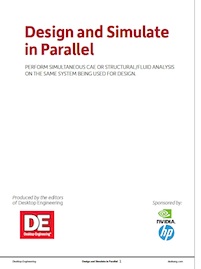Check it Out: Design and Simulate in Parallel
Perform simultaneous CAE or structural/fluid analysis on the same system being used for design.
Latest News
April 1, 2013
 |
You hear a lot about how simulation streamlines product development and minimizes the time and expense associated with physical testing. What you don’t read much about is that you can hobble your workflow when you do not have properly powered equipment to use simulations to their full potential. What you might even hear less about is design workflows where CAE and CAD run on a single engineering workstation simultaneously and efficiently. Today’s Check It Out addresses these matters.
“Design and Simulate in Parallel” explores simulation workflow problems, then covers the probable positive effects of a simultaneous CAE/CAD workflow environment. It focuses on how parallel processing can help engineers access more of the potential of simulation workflows, achieve higher-fidelity simulations faster, and design and simulate on the same workstation simultaneously without that simultaneity adversely impacting application speed and interactivity. This 25-page white paper, produced by Desktop Engineering and sponsored by NVIDIA and HP, has four main sections: Design Optimization Challenges, Speed Product Development with Parallel Processing, Case Studies, and Hardware and Software Considerations.
The first section details the tribulations of optimizing designs on underpowered workstations. It covers some common schemes engineering departments use to cajole overburdened workstations to run simulations or to simply obtain the results. It also looks at the overt and covert costs of these workarounds. In rapid almost painful fashion, this section details how quickly small- and medium-sized businesses sap innovation, lose money, and squander time working with weakling gear for the job.
Section two is the meat of this paper. It explains why hardware and software engineered to support parallel processing is key to simultaneous design and simulation on a single workstation. It describes how this combination gives you back time. Time to iterate. Time to design and simulate in parallel. Time to tweak your simulation. And time to market. The likely advantages of incorporating NVIDIA Maximus technology in an HP workstation are described.
If the second section is the paper’s meat, the three case studies are its seasonings. They provide real-world accounts of simultaneous design and analysis workflows. Managers and engineers at three vastly different engineering concerns relate their experiences before and after adopting parallel-processing workstations and software. Each explains how a more efficient design and analysis workflow enables them to study more design alternatives in less time and to work with higher fidelity simulations most all the time.
The final section is designed to help you determine whether to invest in NVIDIA Maximus technology and, if so, what degree of muscle is right for your CAE/CAD workload. It covers the levels of NVIDIA Maximus performance and pairs NVIDIA technology with degrees of CAE usage. HP workstations to consider for your needs are suggested. Helpful hints on what to beware of with software toolsets and how to calculate your potential return on investment complete this well-rounded discussion.
Each section of this white paper could stand alone as a dedicated paper or case study. As a set, they make a powerful case for adopting a simultaneous design workflow. Such a decision could be a transformational moment in your organization’s history. This paper shows you why and how to begin.
Thanks, Pal. – Lockwood
Anthony J. Lockwood
Editor at Large, Desktop Engineering
Subscribe to our FREE magazine, FREE email newsletters or both!
Latest News
About the Author
Anthony J. Lockwood is Digital Engineering’s founding editor. He is now retired. Contact him via [email protected].
Follow DE





